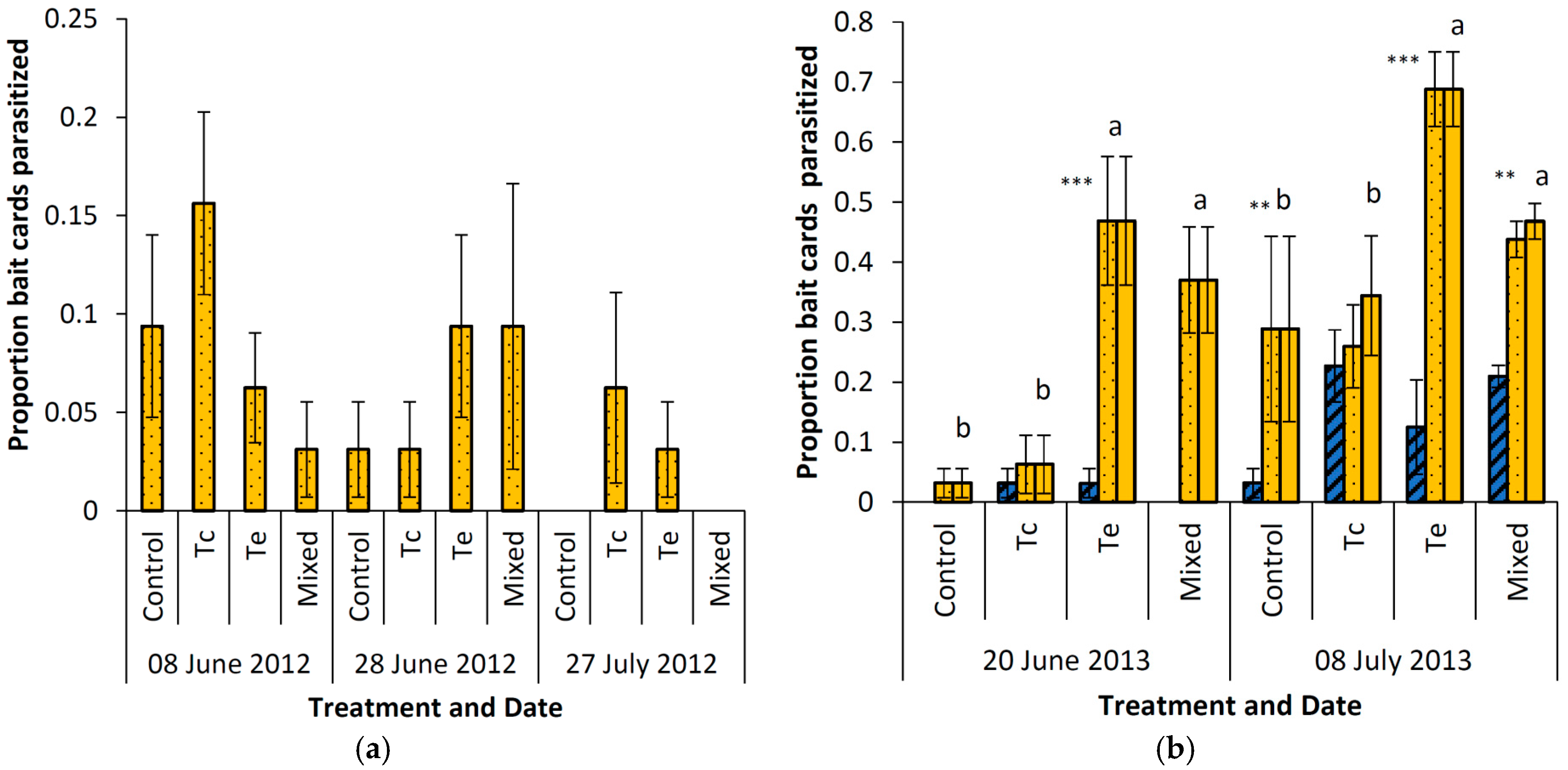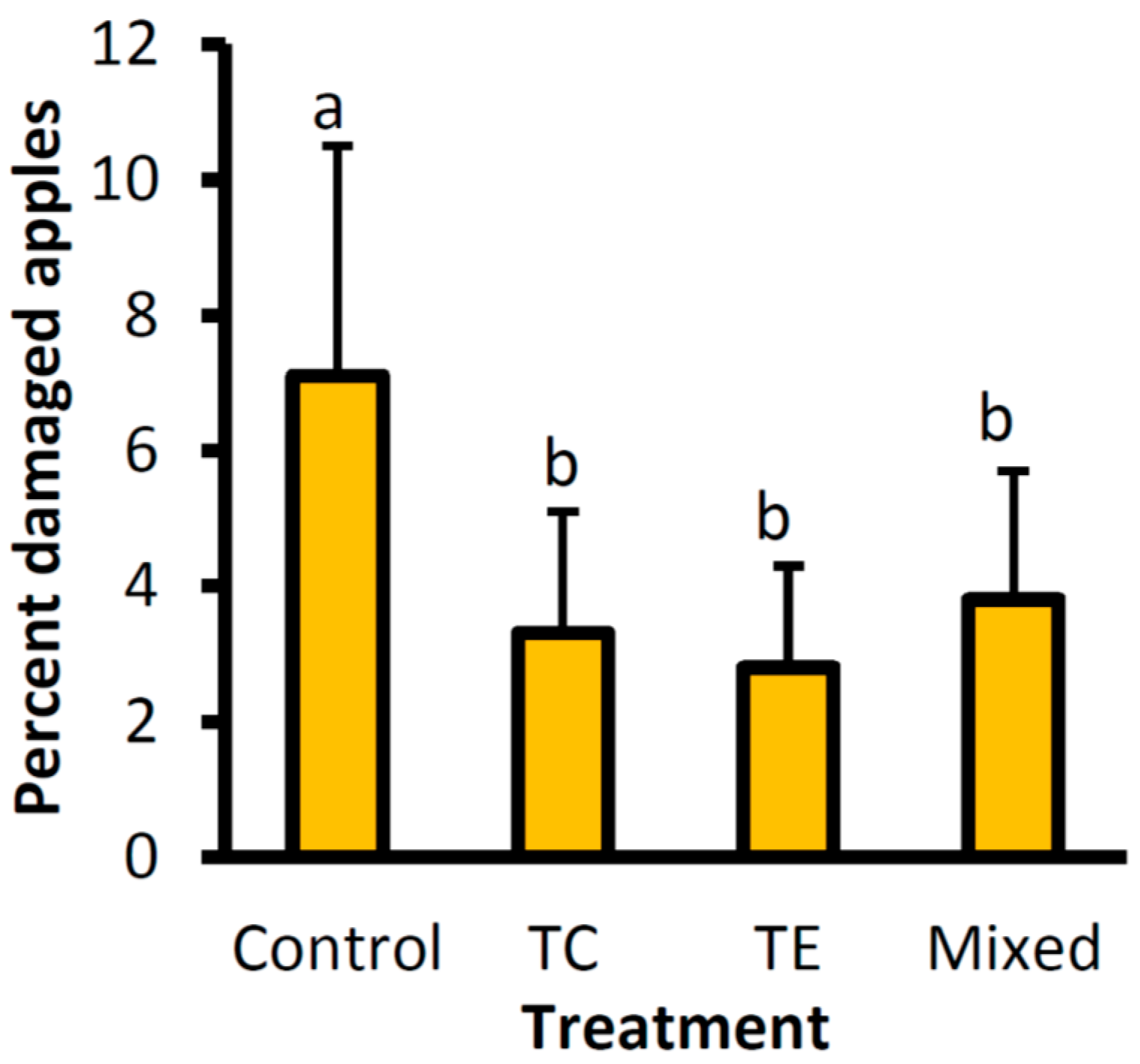Mass Release of Trichogramma evanescens and T. cacoeciae Can Reduce Damage by the Apple Codling Moth Cydia pomonella in Organic Orchards under Pheromone Disruption
Abstract
:1. Introduction
2. Materials and Methods
2.1. Orchards
2.2. Trichogramma Spp. and Bait Cards
2.3. Experimental Design and Field Assessment
2.4. Data Analysis
3. Results
3.1. Trichogramma Releases
3.2. Fruit Damage and Yield
4. Discussion
5. Conclusions
Acknowledgments
Author Contributions
Conflicts of Interest
References
- Naturerhvervsstyrelsen. Statistik over økologiske jordbrugsbedrifter 2015. In Autorisation & Produktion; Naturerhversstyrelsen, Ministry of Environment and Food of Denmark: Copenhagen, Denmark, 2016. [Google Scholar]
- Danmarks Statistik. Detailomsætningen af økologiske fødevarer 2014. In Nyt Fra Danmarks Statistik; Danmarks Statistik: Copenhagen, Denmark, 2015; Volume 195, p. 2. [Google Scholar]
- Axelsen, J.A.; Munk, L.; Sigsgaard, L.; Ørum, J.E.; Streibig, J.C.; Navntoft, S.; Christensen, T.; Pedersen, A.B.; Elkjær, K.; Korsgaard, M.; et al. Udredning Om Moniterings, Varslings-Og Beslutningsstøttesystemer for Skadevoldere I Planteproduktionen I Landbrug, Gartneri og Frugtavl; Miljøstyrelsen: Copenhagen, Danmark, 2012. [Google Scholar]
- Hassan, S.A. The mass rearing and utilization of Trichogramma to control lepidopterous pests—Achievements and outlook. Pestic. Sci. 1993, 37, 387–391. [Google Scholar] [CrossRef]
- Zimmermann, O. Der Einsatz von Trichogramma-Schlupfwespen in Deutschland. Gesunde Pflanz. 2004, 56, 157–166. [Google Scholar] [CrossRef]
- Smith, S.M. Biological control with Trichogramma: Advances, successes, and potential of their use. Annu. Rev. Entomol. 1996, 41, 375–406. [Google Scholar] [CrossRef] [PubMed]
- Samara, R.Y.; Monje, J.C.; Zebitz, C.P.W. Comparison of different European strains of Trichogramma aurosum (Hymenoptera: Trichogrammatidae) using fertility life tables. Biocontrol Sci. Technol. 2008, 18, 75–86. [Google Scholar] [CrossRef]
- Mansfield, S.; Mills, N.J. Host egg characteristics, physiological host range, and parasitism following inundative releases of Trichogramma platneri (Hymenoptera: Trichogrammatidae) in walnut orchards. Environ. Entomol. 2002, 31, 723–731. [Google Scholar] [CrossRef]
- Yu, D.; Hagley, E.; Laing, J. Biology of Trichogramma minutum Riley collected from apples in southern ontario. Environ. Entomol. 1984, 13, 1324–1329. [Google Scholar] [CrossRef]
- Dolphin, R.; Cleveland, M.; Mouzin, T.; Morrison, R. Releases of Trichogramma minutum and T. cacoeciae in an apple orchard and the effects on populations of codling moths. Environ. Entomol. 1972, 1, 481–484. [Google Scholar] [CrossRef]
- Mills, N. Augmentation in orchards: Improving the efficacy of Trichogramma inundation. In Proceedings of the 1st International Symposium on Biological Control of Arthropods, Honolulu, HI, USA, 14–18 January 2002; USDA Forest Service FHTET-03-05. 2003; pp. 130–135. [Google Scholar]
- Kienzle, J.; Zimmermann, O.; Wührer, B.; Triloff, P.; Morhard, J.; Landsgesell, E.; Zebitz, C. New species and new methods of application—A new chance for Trichogramma in codling moth control? Pcoceedings of the Ecofruit. 15th International Conference on Organic Fruit-Growing, Hohenheim, Germany, 20–22 February 2012; pp. 317–321. [Google Scholar]
- Polaszek, A. Species diversity and host associations of Trichogramma in Eurasia. In Egg Parasitoids in Agroecosystems with Emphasis on Trichogramma; Springer: New York, NY, USA, 2009; pp. 237–266. [Google Scholar]
- Boivin, G. Overwintering strategies of egg parasitoids. In Biological Control with Egg Parasitoids; Wajnberg, S.A., Ed.; Hassan, CAB International: Wallingford, UK, 1994; pp. 219–244. [Google Scholar]
- Schöller, M.; Hassan, S.A. Comparative biology and life tables of Trichogramma evanescens and T. cacoeciae with Ephestia elutella as host at four constant temperatures. Entomol. Exp. Appl. 2001, 98, 35–40. [Google Scholar]
- Jehle, J.A.; Herz, A.; Keller, B.; Kleespies, R.G.; Koch, E.; Larem, A.; Schmitt, A.; Stephan, D. Statusbericht Biologischer Pflanzenschutz 2013. In Berichte aus dem Julius Kühn-Institut; Julius Kühn Institute: Darmstadt, Germany, 2014; Volume 173, p. 121. [Google Scholar]
- Trapman, M.; Helsen, H.; Polfliet, M. Development of a dynamic population model as a decision support system for codling moth (Cydia pomonella) management. In Proceedings of the Ecofruit-13th International Conference on Cultivation Technique and Phytopathological Problems in Organic Fruit-Growing, Weinsberg, Germany, 18–20 February 2008; pp. 247–251. [Google Scholar]
- Hassan, S.A.; Kohler, E.; Rost, W.M. Mass-production and utilization of Trichogramma 10. Control of the codling moth Cydia pomonella and the summer fruit tortrix moth Adoxophyes orana Lep, Tortricidae. Entomophaga 1988, 33, 413–420. [Google Scholar] [CrossRef]
- Pintureau, B. Les Espèces Européennes de Trichogrammes; ILV, Ed.; LibroVeritas: Cergy-Pontoise, France, 2008. [Google Scholar]
- Sigsgaard, L.; University of Copenhagen, Thorvaldsensvej 40, 1871 Frederiksberg C., Denmark. Personal Observation, 2013.
- SAS Institute. Sas 9.4 Output Delivery System: User’s Guide; SAS Institute: Cary, NC, USA, 2014. [Google Scholar]
- Hassan, S.A. Selection of suitable Trichogramma strains to control the codling moth Cydia pomonella and the 2 summer fruit tortrix moths Adoxophyes orana, Pandemis heparana Lep, Tortricidae. Entomophaga 1989, 34, 19–27. [Google Scholar] [CrossRef]
- Hassan, S.A.; Hafes, B.; Degrande, P.E.; Herai, K. The side-effects of pesticides on the egg parasitoid Trichogramma cacoeciae Marchal (Hym., Trichogrammatidae), acute dose-response and persistence tests. J. Appl. Entomol. 1998, 122, 569–573. [Google Scholar] [CrossRef]


© 2017 by the authors. Licensee MDPI, Basel, Switzerland. This article is an open access article distributed under the terms and conditions of the Creative Commons Attribution (CC BY) license (http://creativecommons.org/licenses/by/4.0/).
Share and Cite
Sigsgaard, L.; Herz, A.; Korsgaard, M.; Wührer, B. Mass Release of Trichogramma evanescens and T. cacoeciae Can Reduce Damage by the Apple Codling Moth Cydia pomonella in Organic Orchards under Pheromone Disruption. Insects 2017, 8, 41. https://doi.org/10.3390/insects8020041
Sigsgaard L, Herz A, Korsgaard M, Wührer B. Mass Release of Trichogramma evanescens and T. cacoeciae Can Reduce Damage by the Apple Codling Moth Cydia pomonella in Organic Orchards under Pheromone Disruption. Insects. 2017; 8(2):41. https://doi.org/10.3390/insects8020041
Chicago/Turabian StyleSigsgaard, Lene, Annette Herz, Maren Korsgaard, and Bernd Wührer. 2017. "Mass Release of Trichogramma evanescens and T. cacoeciae Can Reduce Damage by the Apple Codling Moth Cydia pomonella in Organic Orchards under Pheromone Disruption" Insects 8, no. 2: 41. https://doi.org/10.3390/insects8020041






